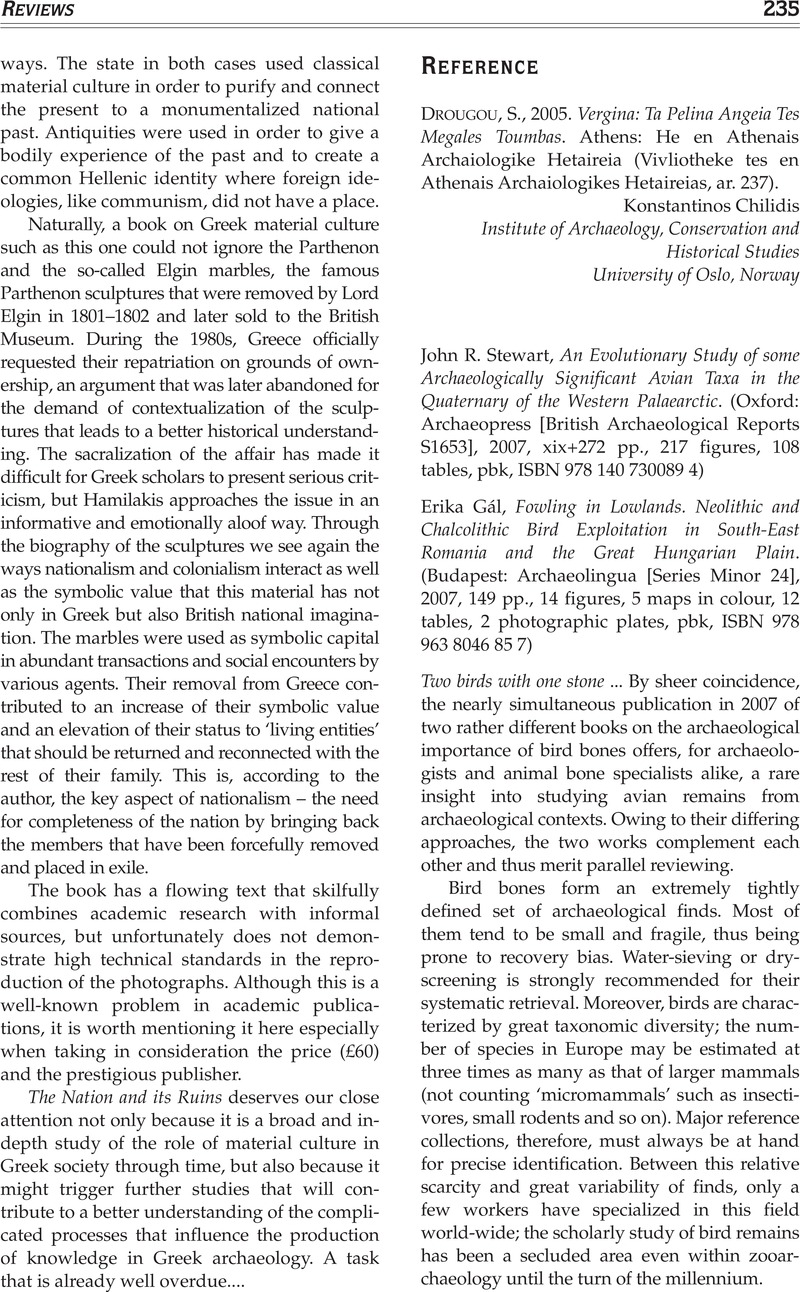No CrossRef data available.
Article contents
John R. Stewart, An Evolutionary Study of some Archaeologically Significant Avian Taxa in the Quaternary of the Western Palaearctic. (Oxford: Archaeopress [British Archaeological Reports S1653], 2007, xix+272 pp., 217 figures, 108 tables, pbk, ISBN 978 140 730089 4) - Erika Gál, Fowling in Lowlands. Neolithic and Chalcolithic Bird Exploitation in South-East Romania and the Great Hungarian Plain. (Budapest: Archaeolingua [Series Minor 24], 2007, 149 pp., 14 figures, 5 maps in colour, 12 tables, 2 photographic plates, pbk, ISBN 978 963 8046 85 7)
Published online by Cambridge University Press: 25 January 2017
Abstract
An abstract is not available for this content so a preview has been provided. Please use the Get access link above for information on how to access this content.

- Type
- Reviews
- Information
- Copyright
- Copyright © 2007 Sage Publications
References
Albarella, U. and Thomas, R., 2002. They dined on crane: Bird consumption, wild fowling and status in medieval England. Acta Zoologica Cracoviensa
45 (special issue): 23–38.Google Scholar
Bartosiewicz, L., 2003. Data on the culture his-tory of crows (Corvidae) in the Hungarian Middle Ages. In Kovács, Gy. (ed.) Quasi liber et pictura. Tanulmányok Kubinyi András hetvenedik születésnapjára (Studies in honour of András Kubinyi on his seventieth birthday):
37–341.Google Scholar
Budapest: ELTE Régészettudományi Intézet.Google Scholar
Becker, C., 2005. Birds, mice, and slaughter refuse from an Islamic mosque in Syria — A puz-zling mixture at a peculiar location. In Grupe, G. and Peters, J. (eds), Feathers, Grit and Symbolism: Birds and Humans in the Ancient Old and New Worlds:
271–280 (Documenta Archaeobiologiae 3). Rahden/Westf.: Verlag Marie Leidorf.Google Scholar
Gál, E., 2003. Adaptation of different bird species to human environments. In Laszlovszky, J. and Szabó, P. (eds), People and Nature in Historical Perspective:
120–138. Budapest: CEU, Department of Medieval Studies & Archaeolingua.Google Scholar
Gál, E., 2006. The role of archaeo-ornithology in the environmental and animal history studies. In Jerem, E., Mester, Zs. and Benczes, R. (eds), Archaeological and Cultural Heritage Preservation:
49–61. Budapest: Archaeolingua.Google Scholar
McGovern-Wilson, R., 2005. Feathers flying in paradise: The taking of birds for their feath-ers in prehistoric Polynesia. In Grupe, G. and Peters, J. (eds), Feathers, Grit and Symbolism: Birds and Humans in the Ancient Old and New Worlds:
207–221 (Documenta Archaeobiologiae 3). Rahden/Westf.: Verlag Marie Leidorf.Google Scholar
Martínez-Lira, P., Corona-Martinez, E., Arroyo-Cabrales, J. and Carpenter, J.P., 2005. Bird bundles from La Playa, Sonora, Mexico. In Grupe, G. and Peters, Grupe. (eds), Feathers, Grit and Symbolism: Birds and Humans in the Ancient Old and New Worlds:
201–206 (Documenta Archaeobiologiae 3). Rahden/Westf.: Verlag Marie Leidorf.Google Scholar
Morales, A. (ed.), 1993. Archaeornithology: Birds and the Archaeological Record, Vol. 1–2 (1992–1993). Madrid: Archaeofauna.Google Scholar
Russell, N. and McGowan, K. J., 2003. Dance of the cranes: Crane symbolism at Çatalhöyük and beyond. Antiquity
77(297):445–455.Google Scholar




